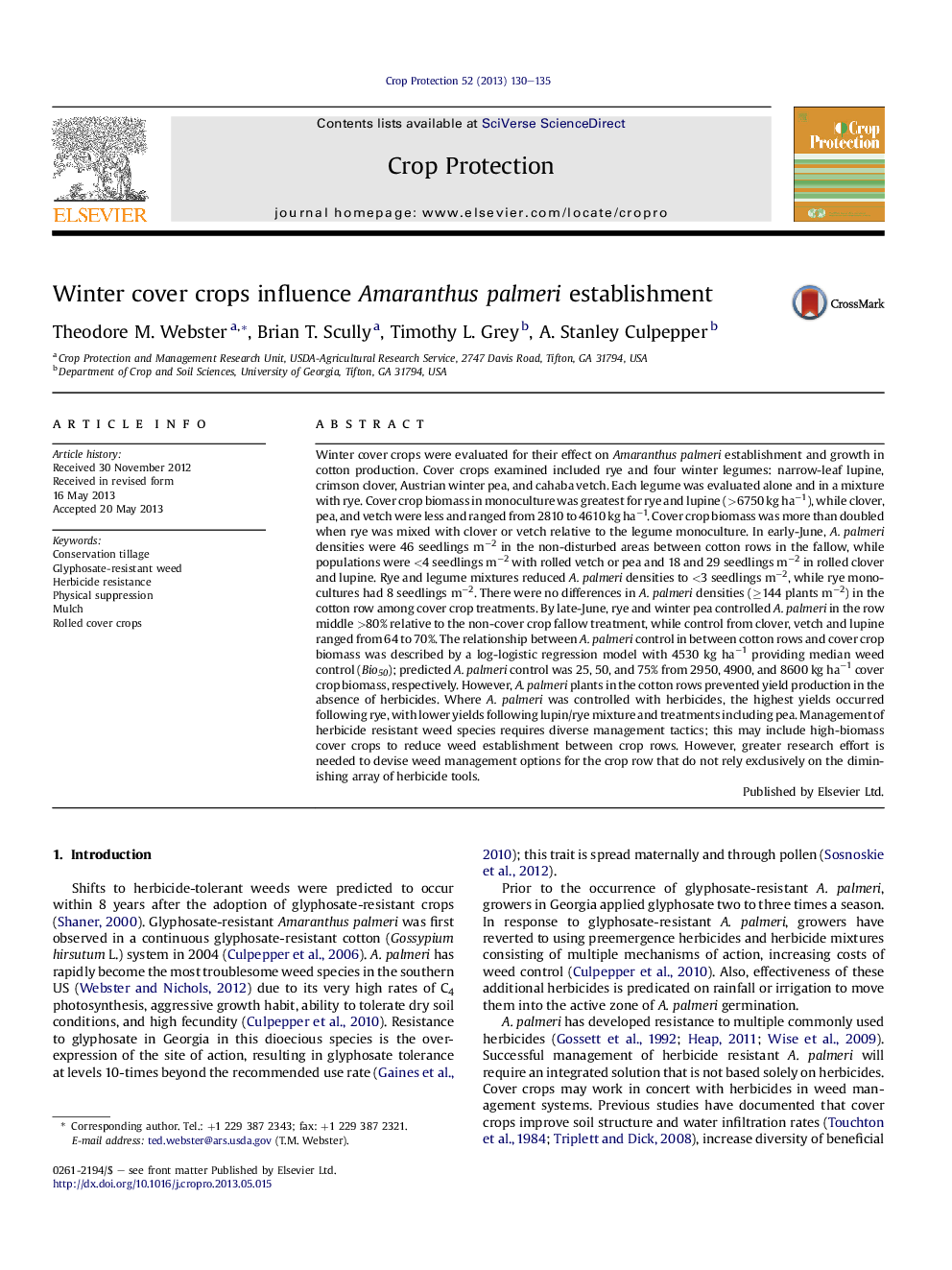| کد مقاله | کد نشریه | سال انتشار | مقاله انگلیسی | نسخه تمام متن |
|---|---|---|---|---|
| 6373858 | 1624335 | 2013 | 6 صفحه PDF | دانلود رایگان |
عنوان انگلیسی مقاله ISI
Winter cover crops influence Amaranthus palmeri establishment
دانلود مقاله + سفارش ترجمه
دانلود مقاله ISI انگلیسی
رایگان برای ایرانیان
موضوعات مرتبط
علوم زیستی و بیوفناوری
علوم کشاورزی و بیولوژیک
علوم زراعت و اصلاح نباتات
پیش نمایش صفحه اول مقاله

چکیده انگلیسی
Winter cover crops were evaluated for their effect on Amaranthus palmeri establishment and growth in cotton production. Cover crops examined included rye and four winter legumes: narrow-leaf lupine, crimson clover, Austrian winter pea, and cahaba vetch. Each legume was evaluated alone and in a mixture with rye. Cover crop biomass in monoculture was greatest for rye and lupine (>6750 kg haâ1), while clover, pea, and vetch were less and ranged from 2810 to 4610 kg haâ1. Cover crop biomass was more than doubled when rye was mixed with clover or vetch relative to the legume monoculture. In early-June, A. palmeri densities were 46 seedlings mâ2 in the non-disturbed areas between cotton rows in the fallow, while populations were <4 seedlings mâ2 with rolled vetch or pea and 18 and 29 seedlings mâ2 in rolled clover and lupine. Rye and legume mixtures reduced A. palmeri densities to <3 seedlings mâ2, while rye monocultures had 8 seedlings mâ2. There were no differences in A. palmeri densities (â¥144 plants mâ2) in the cotton row among cover crop treatments. By late-June, rye and winter pea controlled A. palmeri in the row middle >80% relative to the non-cover crop fallow treatment, while control from clover, vetch and lupine ranged from 64 to 70%. The relationship between A. palmeri control in between cotton rows and cover crop biomass was described by a log-logistic regression model with 4530 kg haâ1 providing median weed control (Bio50); predicted A. palmeri control was 25, 50, and 75% from 2950, 4900, and 8600 kg haâ1 cover crop biomass, respectively. However, A. palmeri plants in the cotton rows prevented yield production in the absence of herbicides. Where A. palmeri was controlled with herbicides, the highest yields occurred following rye, with lower yields following lupin/rye mixture and treatments including pea. Management of herbicide resistant weed species requires diverse management tactics; this may include high-biomass cover crops to reduce weed establishment between crop rows. However, greater research effort is needed to devise weed management options for the crop row that do not rely exclusively on the diminishing array of herbicide tools.
ناشر
Database: Elsevier - ScienceDirect (ساینس دایرکت)
Journal: Crop Protection - Volume 52, October 2013, Pages 130-135
Journal: Crop Protection - Volume 52, October 2013, Pages 130-135
نویسندگان
Theodore M. Webster, Brian T. Scully, Timothy L. Grey, A. Stanley Culpepper,